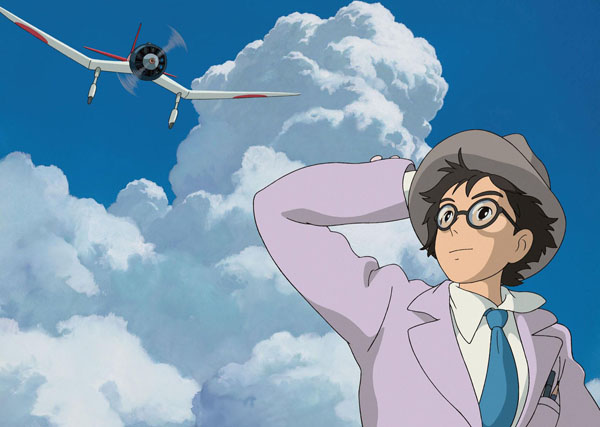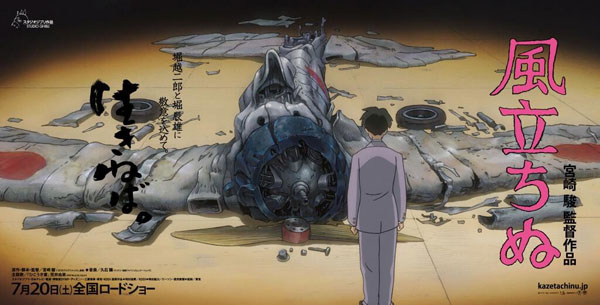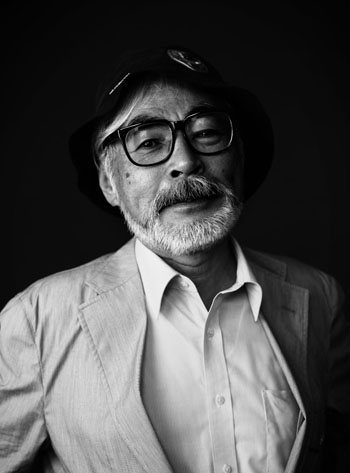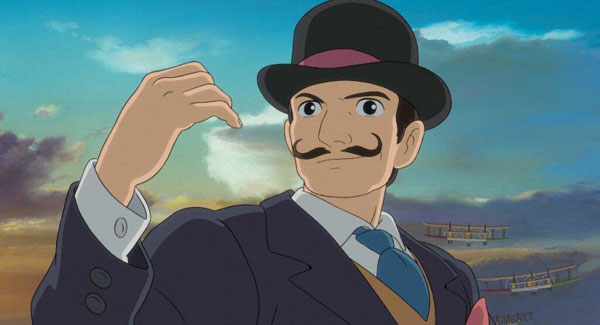Opening in Japan tomorrow (Saturday, July 20), Hayao Miyazaki’s The Wind Rises is “a work based on the lives of Jiro Horikoshi, designer of Japan’s legendary Zero fighter plane, and mid-20th-century writer Tatsuo Hori,” reports Tomomi Sunaga in the Japan Times. “Horikoshi was one of the ‘most brilliant’ Japanese in the early, turbulent years of the Showa Era (1926-1989), when Japan charged toward war, Miyazaki, 72, said in a recent interview… ‘I’ve been producing animated movies for the sake of children, so I wondered if I should make a film about a man who developed weapons,’ said Miyazaki…. ‘It was wrong from the beginning to go to war,’ Miyazaki added. ‘But as the Japanese opted for war, it’s useless to blame Jiro for it. Basically, engineers are neutral.'”
“Instead of a fantastic world and otherworldly creatures, viewers can expect a story based on reality, but is still about pursuing dreams and discovering love, even in the aftermath of disaster and on the brink of war,” writes Ida Torres in the Japan Daily Press. “Jiro is just a simple but industrious engineer whose dream is to design a plane that would change the world. His mission in life is to ‘do what he can with utmost sincerity,’ something that he shares with Hori’s beliefs. Miyazaki merged the two persons he had great admiration for into a single character that would hopefully make the audience think about what they’re living for, even if the characters lived in the early 20th century.”
The first full-on review comes from Mark Schilling in the Japan Times (3.5 out of 5 stars). Schilling finds Miyazaki “rework[ing] antique formulas such as ‘bright young man makes good’ and ‘young lovers are parted by cruel fate’ that powered many a studio film when Miyazaki himself was younger…. So, yes, The Wind Rises is an old-fashioned tearjerker, but it is also a visually sumptuous celebration of an unspoiled prewar Japan. At the same time, Miyazaki inserts reminders of the era’s social and economic turmoil and hints of later environmental calamities, as well as stark visions of the war that would sweep much of the old loveliness away. By the end, the film feels like a summing up of everything he’s made and cherished and fought against to date and, perhaps, a swan song. If so, he’s crafted a soaring goodbye on the wings of his beloved planes—and paper touched by the hand of genius.”
A few weeks ago, we noted that Atsushi Ohara had reported on a news conference at Studio Ghibli Inc. in Tokyo for the Asahi Shimbun. Miyazaki “revealed that he became overwhelmed with emotion when watching his completed work, saying: ‘I have been creating animations for 50 years. In this work, many elements from my life, such as books I have read, songs I have heard, and people I have met, came together.’ He added with a sheepish grin, ‘It was the first time (that I cried after watching my film). It’s embarrassing.’”
Meantime, the Anime News Network‘s posted a music video that “not only offers a sneak peek at the film itself, but also a rare glimpse inside the Ghibli Museum.” ANN also reports that Miyazaki’s denying that The Wind Rises is his final work.
One more note for now from C. Edwards at Cartoon Brew: “As reported by Anime News Network, documentary filmmaker Mami Sunada (Ending Note: Death of a Japanese Salaryman) is nearing completion on the Studio Ghibli documentary Kingdom of Dreams and Madness. The film follows studio producer Toshio Suzuki, and directors Hayao Miyazaki and Isao Takahata (Grave of the Fireflies) as they work on two upcoming Studio Ghibli films, Kaze Tachinu (The Wind Rises) and Kaguya-hime no Monogatori (The Tale of Princess Kaguya).”
Update: Via Twitch, a new four-minute trailer that begins at around 1’17”: Now replaced with a subtitled trailer from the Toronto International Film Festival:
Update, 7/21: “The film is instantly recognizable as a Ghibili production, especially in the character design and attention to detail,” writes Christopher O’Keeffe at Twitch. “Swirls of smoke and dancing shadows are some of the neat touches that bring these pictures to life. What is perhaps unique is the extensive use of long shots to capture a single character surrounded by a mass of green or a clear blue sky or a train hurtling through the countryside. A stunning sequence of the 1923 Great Kanto Earthquake and panoramic shots of cramped and cluttered wooden towns, really give the film an epic quality and anchor it all so firmly in its time and place…. Despite the frequent flights into fantasy The Wind Rises is a film very much bound in reality… A touching romance helps lend the film a softer edge, although I couldn’t shake the feeling that there was something off about a film on the life of the man who designed a plane for the Japanese Imperial Army, no matter how innocent the intent (Ghibili’s or Jiro’s).”
Update, 8/16: Four weeks after its release in Japan, The Wind Rises is still #1 there, notes Vadim Rizov at the Dissolve, where he then outlines a few of the debates the film has sparked at home and elsewhere. “In an essay written in Neppu (a monthly periodical issued by Miyazaki’s Studio Ghibli), Miyazaki wrote, ‘If I had been born a bit earlier, I would have been a gunkoku shonen [militarist youth],’ but as someone born in 1941 whose father ran a post-war club serving occupying American soldiers, he ‘had a strong feeling in my childhood that we had “fought a truly stupid war.”‘” Anime critic Ryusuke Hikawa sees Miyazaki warning against the rise of another wave of nationalism; and Matthew Penny outlines Miyazaki’s vision of an ideal Japan.
Update, 8/30: “As grown-up as 2008’s Ponyo was tot-friendly, Miyazaki’s 11th feature draws a sober, socially astute portrait of Japan between the two World Wars, marked by flights of incredible visual fancy, harrowing images of poverty and destruction, and touches of swooning romance,” writes Variety‘s Scott Foundas.
Updates, 9/1: Studio Ghibli president Koji Hoshino has officially announced in Venice that Miyazaki will retire, reports Peter van der Lugt at Twitch: “A dedicated press conference is to follow next week in Japan.”
“No one in animation—whether hand-drawn, computer-generated or a sleek fusion of the two—is creating canvases quite this epically fluid and color-saturated, yet still alive with witty individual flourishes,” writes Guy Lodge, reviewing The Wind Rises at In Contention. “Miyazaki’s films are utterly distinguishable from those of other directors in the Ghibli stable, with this one more distinct still. It’s as if working in a mode of (relative) narrative realism has necessitated his most florid vision yet.”
“Gone are the loopy, expressionist flights of fancy, the (occasionally hectoring) environmental sub-themes and the customary panoply of cute critters and goofy comic side-players,” writes David Jenkins at Little White Lies. “In their place, though, is a melodrama so earnest, rousing and robustly built that you’d swear it could’ve come out of Hollywood in the 1940s.”
“[B]eyond the love of planes, this feels like perhaps the director’s most personal film,” suggests Oliver Lyttelton at the Playlist. “It might not be the director’s most immediately accessible film, but it’s among his most fascinating and beguiling.”
“As an avowed Miyazaki-ite, did I love The Wind Rises?” asks the Telegraph‘s Robbie Collin. “On a first watch, no—but it strikes me that fanboyish adoration would be entirely the wrong response to this film, just as you wouldn’t walk out of a late-period Ozu or Bresson punching the air and whooping for a sequel. ‘Artists are only active for ten years,’ one character tells Jiro. ‘We engineers are the same. Live your ten years to the full.’ Miyazaki, who is both artist and engineer, has now lived his decade three times over, and yet he continues to astonish.”
But the Guardian‘s Xan Brooks finds The Wind Rises to be “gorgeous yet ultimately frustrating… Here is a film with a clean outline and a foggy center. I wanted to love it, tried to love it and then went down in flames. It turns out that it is not always possible to view the beauty in isolation. Sometimes you need to take a long, hard look at the outside world and then perhaps connect the two.”
Screen‘s Lee Marshall suggests that “the paradox of the exercise is that in presenting a precise historical setting and period… and partly shutting out the fantasy world of films like Spirited Away or My Neighbor Totoro, Miyazaki loses some of the imaginative force and shape-changing magic that draws hordes of adults even to his ‘children’s’ films.”
Update, 9/2: Miyazaki “lavish[es] on movie-goers the landscapes of destruction, infernal and Turneresque,” writes the Financial Times‘ Nigel Andrews. “The first is the 1923 Kanto earthquake, a living canvas of roiling fires and houses drowning in terra firma. Romance and marriage with a consumptive girl provide a time out of violence, if not out of tragedy. (Tuberculosis was rife at that time.) There are comical cameos classically Miyazaki: a barking, frog-faced factory boss, a watercress-munching German spy. But the great achievement of this film is its balanced fluctuation between an exultant rapture in human inventiveness (and the hopes it can hold for a better future) and an unsparing horror at the catastrophes spun by both man and nature.”
Updates, 9/3: “Stark history and buoyant fantasy often link arms in The Wind Rises,” writes Time‘s Richard Corliss. “When Caproni says, ‘Inspiration unlocks the future; technology will catch up,’ he might be anticipating the untrammeled dreams of directors like James Cameron, Ang Lee and Alfonso Cuarón nearly a century later…. Whatever the political implications of a movie that glamorizes and elegizes the makers of war, The Wind Rises shows Miyazaki at his most confident. The film betrays no hint of sapping energy, let alone senility; it is vigorous, subtle, daring and gorgeous. May his announced retirement be a brief, dark whim. May he go on enchanting and challenging moviegoers for years to come.”
“The Wind Rises can be largely forgiven for its apolitical outlook, as Miyazaki trades an interest in the ramifications of Horikoshi’s work for his continuing investment in it,” writes Indiewire‘s Eric Kohn. “Horikoshi’s commitment to crafting an apparatus on par with the ethereal machines he imagines can be easily seen as a vessel for Miyazaki to explore his own creative process. Having proven his talent time and again, the master has explained himself.”
The Hollywood Reporter‘s Deborah Young predicts that The Wind Rises “will divide audiences into two camps, those who find it an unforgettably beautiful and poetic ode to life, and those who tune out to its slow-moving second act, which can wear down the patience of even the well-disposed.”
Update, 9/7: From the Japan Times, a video with subtitles: Miyazaki formally announces his retirement:
Update, 9/12: Cartoon Brew‘s Amid Amidi has the dates for Disney’s North American rollout. There’ll be brief runs in New York and Los Angeles of the original Japanese version with subtitles. These are “Academy Award qualification engagements”; The Wind Rises then hits theaters in February, and most assume that that version will be dubbed.
Updates, 9/14: “Though The Wind Rises is based on a real person,” writes Noel Murray at the Dissolve, “it’s very much a Miyazaki film, blending dream sequences, gentle character comedy, and shattering eruptions of violence into its sketch of early 20th-century Japan. Most of the movie is about Horikoshi’s (fictional) love affair with a young artist suffering from tuberculosis, and how she gives him a broader perspective on life even as her illness distracts him from his job. Their romance gives what could’ve been a dry nostalgia piece a beating heart, strengthened by Miyazaki’s ability to conjure up any part of the past he likes with pen and ink.”
At the AV Club, A.A. Dowd finds it “more pleasant than transporting, even as it boasts some of the loveliest animation in Studio Ghibli history…. As usual, though, Miyazaki proves more adept at creating (or in this case, re-creating) worlds than populating them with compelling characters. This isn’t a problem when the director is working in the idiom of fantasy, but it proves more detrimental here, as there are no wood creatures or floating castles to distract from the one-note earnestness of the protagonist.”
Updates, 9/17: “The most sophisticated of his films, The Wind Rises is filled from beginning to end with stunningly composed ‘shots’ and an intricate sound design, at times ecstatic, and at others focused to the point of being muted,” writes Adam Cook in the Notebook. “It is also one of the most classically made films of the year, and finds Miyazaki working within a mode I fear we won’t see animation tackle again without him.”
“The fragile pastel watercolors are beautiful,” grants R. Emmet Sweeney in the L, “but I miss the fantastical eye-popping blues of Ponyo. Miyazaki has always excelled at normalizing the fantastic, as in My Neighbor Totoro, but here he has to fantasize the normal, and he seems uncomfortable—he inserts dream sequences to make up for this reversal. The film feels as grounded as Jiro, whose nearsightedness kept him from becoming a pilot.”
For news and tips throughout the day every day, follow @KeyframeDaily on Twitter and/or the RSS feed. Get Keyframe Daily in your inbox by signing in at fandor.com/daily.








